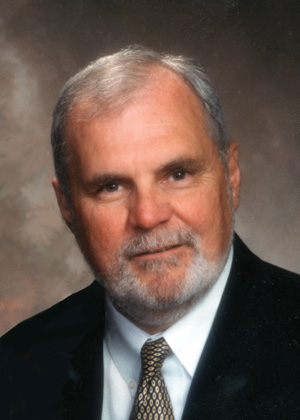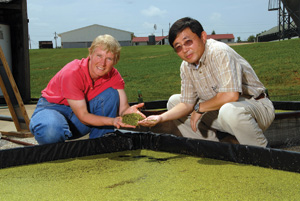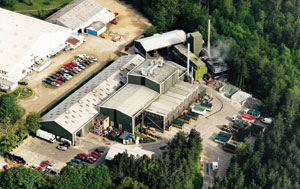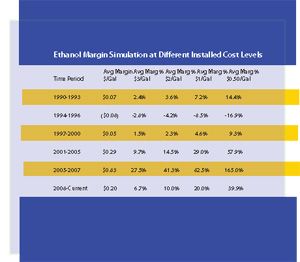August 2009
 View Full Print Edition
View Full Print EditionBusiness Briefs
Columns

Ethanol Industry Financing Challenges Continue
By Michael L. Weaver

The Global Ethanol Market
By Robert Vierhout

Take Back the Message
By Mike Bryan

RT @ethanolbob #Ethanol in Soc Ntwking
By Bob Dinneen

Bewildered by Biomass
By Rona Johnson

Reward Carbon Mitigation in Every Industry
By Tim Portz

Diesels: A Look Back and Ahead
By Ron Kotrba

Jingles , Catchy Tunes and the Facts
By Don Scott
Featured

Everything 'Old' can be New Again
By Kris Bevill
A biomass conversion technology developer has created a plan for large, grain-based ethanol producers to host cellulosic ethanol facilities, and reap the energy rewards.

Covering Your Grass
By Ryan C. Christiansen
Some ventures to produce cellulosic ethanol propose using dedicated energy crops such as switchgrass and miscanthus as feedstocks. However, unlike row crops, dedicated energy crops are not supported by crop insurance programs. What is being done to level the playing field?

Duckweed ‘Quacks' Volumes of Potential
By Bryan Sims
Since the late 1960s, scientists have studied duckweed for animal and human consumption because of its high protein content. Researchers are now tapping into the plant's innate environmental benefits, from desalinating wastewater to exploring its potential as a viable starch-based feedstock for ethanol production.

A Call to Action
By Hope Deutscher and Erin Voegele
Although the ethanol industry is currently facing numerous challenges in both public perception and economics, speakers at this year's International Fuel Ethanol Workshop and Expo encouraged attendees to take action - address the challenges head on and look to the future of the industry and the potential benefits of cellulosic ethanol.
RFS2: Bridging the Gap to Advanced Biofuels
By Erin Voegele
If corn-based ethanol is the bridge to next generation biofuels, then the U.S. EPA's proposed rulemaking for the second stage of the renewable fuel standard (RFS2) may be the driving force to launch that journey. While still supportive of the corn-based ethanol industry, the RFS2 program clearly requires the biofuels industry to step-up efforts to commercialize next generation technologies.
The Cellulosic Ceiling
By Ryan C. Christiansen
The renewable fuel standard calls for 100 MMgy of cellulosic biofuel to be blended into the nation's fuel in 2010, ramping up to 16 billion gallons per year in 2022. Will the U.S. produce enough to satisfy the mandate?

Slow and Steady Wins the Race?
By Hope Deutscher
While the U.S. ethanol market has grown by leaps and bounds, the Canadian industry has grown at a slow, steady pace. As the country's industry grows to meet demand, rather than outpacing it, leaders say Canada is well-positioned to handle future growth as needed.

A Lasting Legacy
By BBI Editorial Staff
Friends and colleagues of Kathy Bryan share stirring memories of her inspirational life and career.

MSW Spells Self-Sufficiency for Isle of Wight Residents
By Lisa Gibson
U.K. island uses gasification technology to turn municipal solid waste into power , bringing it closer to energy independence.
Aquatic Biomass in the Gasification Equation
By Anna Austin
Utilizing a technology developed at the U.S. DOE's Pacific Northwest National Laboratory, Utah-based Genifuel Corp. is working to gasify aquatic biomass into natural gas for use in pipelines and power generation.
A gasification technology developed for railroad ties will provide a clean way to dispose of the creosote-treated materials, and create jobs and energy for aboriginal communities.
A Colossal Conversion
By Anna Austin
Xcel Energy is converting the last coal-fired boiler at Bay Front Power Plant in Ashland, Wis., to run solely on biomass. Through the implementation of a gasification technology, it will become the largest biomass-fired power plant in the Midwest.
Cleaner, Faster, Stronger
By Nicholas Zeman
New diesel technologies offer consumers high-performance, excellent fuel economy and the biodiesel industry a chance to sell its fuel into a market sector that has historically been elusive. New production efforts, new models and favorable government programs are setting the stage for an expansion of the diesel presence in the United States. It's mostly European companies, however-and not domestic producers-who are hoping to bring consumers into the diesel fold.
Diesel's Pioneering Spirit Survives Despite His Untimely Death
By Nicholas Zeman
Sometimes the world is reminded that despite its massive mechanics, its constant change, its tendency to obliterate anything that opposes its will, a single life-or death in this case-can change it all. When Rudolf Diesel disappeared from a ship in the English Channel en route from Antwerp to London to attend the annual meeting of Consolidated Diesel Manufacturers, much more was expected of him.

Milestones in Diesel Technology
By Ron Kotrba
There have been significant advancements in technology since the late 1800s when Rudolf Diesel invented the engine bearing his name. Here is an overview of the diesel engine's evolution.
California Carbon Counting
By Susanne Retka Schill
Soy biodiesel's carbon score came in disappointingly low for preliminary scoring done for California's Low Carbon Fuel Standard, but California's new regulation may not all be bad news for the biodiesel industry.
Contributions
Sourcing Equipment in Developing Countries While Minimizing Risk
By Gregory T. Benz and Ling Du
Purchasing operating equipment out-of-country can save money, but it is necessary to take the proper steps to ensure a quality product.

How Consolidation can Affect Shareholder Value
By Scott McDermott
Consolidation has been a way of business, particularly in the food and agriculture sectors, for up to 100 years, in some cases. In a period of industry stress such as is currently being experienced in the ethanol industry, it is important to step back and review what history teaches us about consolidation and what it could mean to the creation and destruction of shareholder value.
The components of a working reverse osmosis system are few — a pump, some membranes, vessels and plumbing. The challenge is to operate it in a way that minimizes membrane fouling, maximizes membrane life, and avoids hydraulic catastrophes.

Gasification Technologies: Making Second-Generation Biofuels a Reality
By Marie-Helene Labrie
Enerkem's gasification technology provides a solution for some of the challenges facing cellulosic ethanol producers, including high manufacturing cots and the volume of feedstock required.

Filling a Need: Forest Plantations for Bioenergy in the Southern US
By Ronalds Gonzalez, Dr. Jeff Wright and Dr. Daniel S
The growing number of renewable energy projects in the Southern U.S. utilizing woody biomass will require the development of short-rotation bioenergy plantations.









